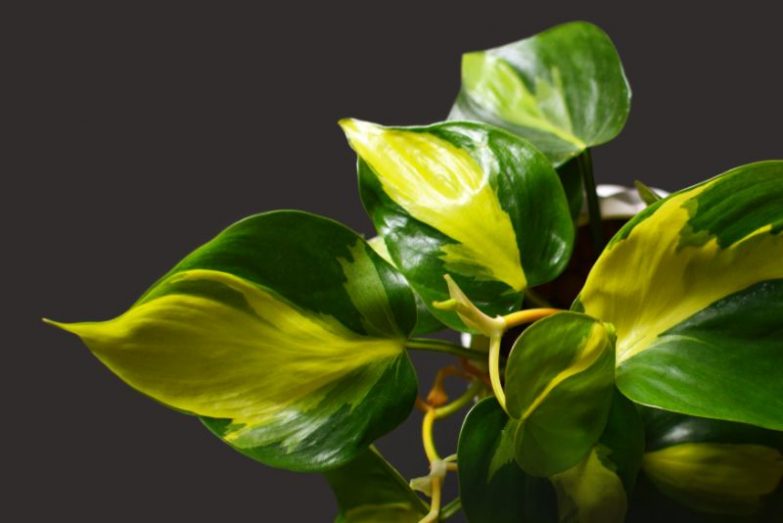It’s hard to believe the stunning Philodendron Brasil is one of the best beginner plants of all time. The dark green leaves with cream- and lime-colored neon splotches look like those of a fussy magazine-cover plant. Yet Philodendron Brasil tolerates a wide range of conditions and even some neglect. This article will cover all you need to know about Philodendron Brasil care, to help you get the most from this tropical beauty.
Philodendron ‘Brasil’ tolerates low light but prefers bright, indirect illumination. Its well-draining soil should dry halfway before watering. The plant likes warm room temperatures year-round, can handle normal humidity, and is hardy against pests and disease. Fertilize regularly during the growing season.
Overview Of Philodendron Brasil
Philodendron Brasil only looks like a temperamental diva: it’s actually an easy-going, low-maintenance cultivar of the famous Heartleaf Philodendron. A fast-growing evergreen plant native to the Caribbean and Central America, it has spread its friendly vines on windowsills across the world.
The glossy, heart-shaped foliage is a combination of solid green and variegated leaves that feature a cream center stripe surrounded by lime-green swatches that look painted on. Every leaf has its own color pattern – each plant is unique. Its vines can climb or trail and may reach from 10 to 20 feet long.
Part of this new favorite’s charm is how spectacularly simple Philodendron Brasil Care is – it’s as if nature relented and gave everyone the chance to enjoy an eye-catching tropical classic. Even if they don’t receive the most optimal care, the forgiving Philodendron Brasil carries on.
Of course the plant looks its best with proper care. It can lose variegation and become leggy in poor light … it can slow down or develop bare spots on top without proper water or fertilization. But it propagates in a water glass; and, though toxic to consume, it’s not prone to disease or pest infestation.
Philodendron Brasil Care Summary
| Scientific Name | Philodendron hederaceum ‘Brasil’ |
| Light Requirements | Bright, indirect light, but will tolerate lower light quite well. |
| Watering | Water thoroughly once the top half of the soil is dry. |
| Soil | Loose, well-draining potting medium. A 50:50 mix of peat or coco coir and perlite is a good option. Here are some excellent pre-made mixes. |
| Temperature | Tolerant to a wide range of temperatures from 60F (15ºC) to 86ºF (30ºC) or even higher. |
| Fertilizer | Fertilize monthly with a balanced fertilizer when actively growing. It is better to apply fertilizer sparingly on a regular basis. |
| Humidity | Tolerant of a wide range of humidity levels, but prefers average to high humidity. |
| Flowering | Insignificant inflorescences, but unlikely to flower indoors. |
| Pruning | Easy to prune to maintain desired size and remove dead foliage. |
| Propagation | Very easy to propagate stem cuttings in soil or water. |
| Re-Potting | Repot in spring when showing signs of becoming rootbound. |
| Diseases and Pests | Fairly resistant to pests and recovers quickly if affected. Prone to bacterial and fungal leaf spot diseases in wet conditions. |
| Toxicity | Mildly toxic to humans and animals if ingested. |
| Where To Buy | Buy Philodendron Brasil online at Etsy (I buy most of my houseplants from Etsy). |
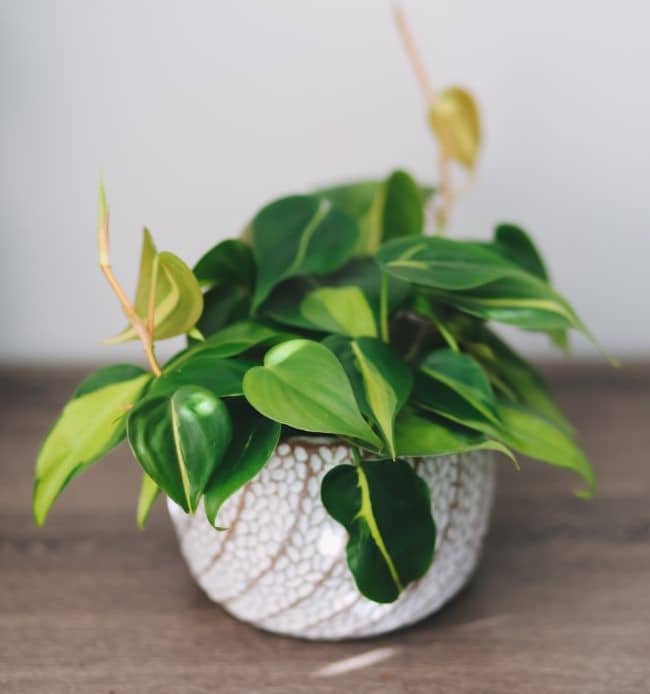
Philodendron Brasil Light Requirements
Philodendron Brasil is often considered a low-light plant, but they actually do better in bright, indirect lighting.
East- and west-facing windows are generally excellent locations to provide good Philodendron Brasil care. They also do well in the strong light of a southern exposure if placed a few feet away.
Artificial illumination is another good option. If you want to put them in a north-facing window or another spot without much ambient light – for example, the center of a room – artificial light can make up the difference.
How To Water Philodendron Brasil
Philodendron Brasil isn’t fussy about watering; though, like most plants, they hate being overwatered. They aren’t as susceptible to root rot as many tropicals, but they aren’t invulnerable. Even if they don’t succumb to root rot outright, soil that stays too wet can slow their growth and cause smaller leaves.
The plant’s soil can become fairly dry without protest, but it doesn’t like drought. Let the soil dry out about halfway before watering – the top two inches at a minimum. Use your finger to check; don’t depend on a schedule.
Note: A pot’s material affects watering frequency. Terracotta pots promote faster evaporation because they are more porous than glazed or plastic containers.
The following are signs to watch for. Overwatering and underwatering can show similar symptoms, so check the roots and soil if you aren’t sure.
- Yellow leaves usually means overwatering … but chronic drought also stresses leaves.
- Foliage with brown edges usually means underwatering. Leaves that turn completely brown can mean root rot from overwatering.
- Wilting is caused by a lack of internal pressure: Underwatered foliage wilts from lack of water; overwatering can rot the roots and starve the leaves.
A Soilless Mix Is Best
The Philodendron Brasil is a hemiepiphyte that can live part of its life in a tree canopy. It doesn’t need traditional soil.
Because of this, the plant does best in a loose and well-draining mix with good water retention. Soilless mixes of sphagnum peat moss or coco coir work well. Adding 50% perlite to a regular potting mix can be effective, too, but avoid excessive organic amendments as these can decompose and become compacted. Read my guide to choosing houseplant soil for more information.
Note: The need for fertilization increases in a soilless medium.
Humidity Is Not Critical
Another reason the Philodendron Brasil is such an exceptional low-maintenance plant is its tolerance of dry air indoors.
Like most tropicals, however, they do appreciate higher humidity. They tend to grow faster and produce larger leaves with more moisture in the air.
Indoor heating in wintertime can cause issues: if the plant looks lackluster and its leaves are developing brown edges, consider grouping it with other plants, placing humidity trays nearby, or read this article for more ideas for how to improve humidity for your houseplants.
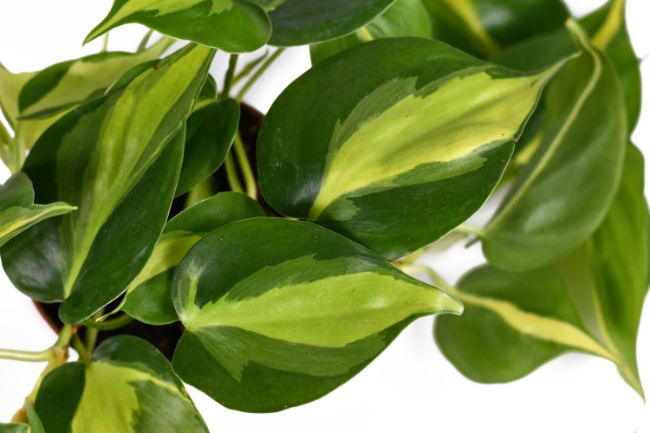
Philodendron Brasil Temperature Requirements
Another friendly characteristic of Philodendron Brasil care is that it thrives at room temperatures. It actually has a larger comfort range than we do and is happy at temperatures from 60F (15ºC) to 86ºF (30ºC) or even higher.
The plant can live outdoors year-round in USDA Zones 11 and above. They are definitely not frost-tolerant and shouldn’t face temperatures below 50ºF (10ºC).
The Brasil grows better at the warm end of the thermometer. They can take extreme levels of high heat above 100ºF (38ºC) too, but in those conditions make sure their soil moisture is sufficient and they have bright indirect lighting.
Regular Fertilization
The Philodendron Brasil grows quickly in the warm season, which can be year-round for an indoor plant. Fertilize according to how fast they’re growing.
Some owners make two or three evenly-spaced applications from spring through summer; others feed a half-strength monthly dose. Another method is to dilute the formula even more heavily and apply when you water.
Here are some popular and effective fertilizers:
Fish emulsion – This organic product is great if you can stand the smell (it actually dissipates quickly when well diluted). It’s safe and delivers a good nutrient profile.
Worm Castings – This pricier organic alternative is odor-free and easy to apply: simply scatter the castings on the soil and water in.
Slow-release Blend – A fast-growing Philodendron can do well with formulas that slowly release nutrients into the soil.
Other Synthetics – Liquid fertilizers or those dissolved in water are easy to measure and apply. They’re economical and can produce good results. Dilute to half or a quarter of the recommended amount, and flush the soil each time you water.
Undernutrition isn’t common for most plants, but a prolific Philodendron in a soil-free mix occasionally has this issue. The following are signs the plant is running low on fuel:
- Slow Growth – Take note if the weather is warm and the plant has adequate light and water, but you’re not seeing growth.
- Small Leaf Size – Consider the soil’s fertility if your Brasil has small leaves.
- Pale New Growth – New foliage that lacks color can mean the soil doesn’t have enough essential micronutrients, especially calcium and/or magnesium.
Check out this article that covers all you need to know about fertilizing houseplants to learn more.
Forget Flowers
The Philodendron Brasil seldom blooms in potted captivity, but don’t worry: you’re not missing much! Even if you created an indoor rainforest, it would take years of growth before the plant would reach flower-bearing age.
The blooms aren’t real flowers, anyway: they are inflorescences like that of a Peace Lily, composed of a spadix and spathe. Also, you can propagate cuttings more easily than seeds … we can leave the plant’s flowering habits to Mother Nature and enjoy the amazing foliage.
Pruning
Pruning an easy but important aspect of Philodendron Brasil care. Grooming by removing dead or damaged foliage is its most basic form, but the plant also responds well to having leggy vines cut back.
Trimming stems stimulates growth from its remaining nodes – the vine doesn’t branch from the cut, but pruning can trigger new leaves from nodes up the stem. This helps create a bushier plant.
Note: It’s also necessary to correct conditions that caused the original legginess!
Sterilize your cutting tools with isopropyl (rubbing) alcohol, or use another effective method. Avoid spreading disease by wiping the blade with an alcohol-soaked cloth between cuts.
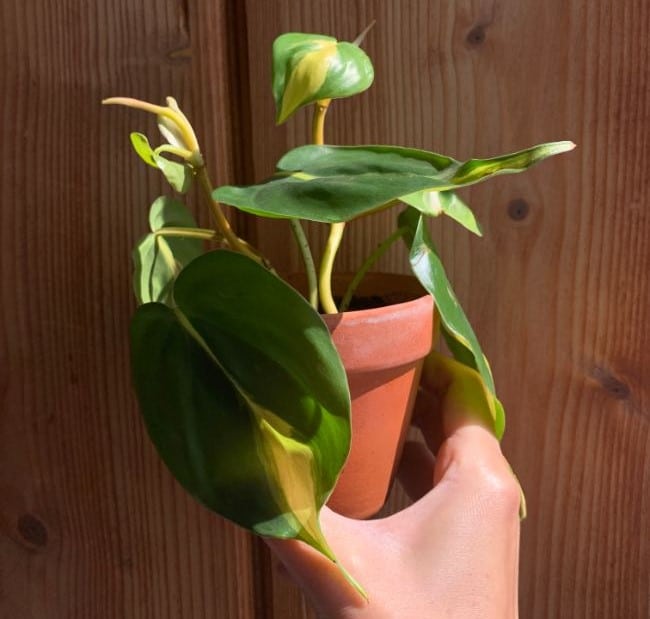
Repotting Philodendron Brasil
Philodendron Brasil doesn’t generally need frequent repotting. It seems to produce larger leaves more quickly when a little snug in its pot.
Here are times when repotting is a good idea:
- Every two years is a typical interval for potting up one container size.
- If your plant is needs more frequent rewatering than it used to, the roots may have consumed the soil.
- It’s probably time to repot when roots are circling the bottom of the pot and emerging from the soil and drain holes. (Some aerial roots are natural – we’re talking extremes.)
- More frequent repotting in sterile media may be a good idea after a pest or disease issue.
Spring is the usual season for repotting, but it can be done any time the plant is growing.
Don’t plant in a significantly larger pot. Extra soil space can hold too much water and make Philodendron Brasil care more challenging. Read my guide to repotting rootbound houseplants to learn more.
Propagation
Every pruning session is a propagation opportunity! In fact, the only part of the stem you can’t propagate is the tip and emerging leaves. Each leaf node can make a baby Brasil, so a stem can yield multiple cuttings.
The vine has conveniently spaces out clusters of small roots: just cut them in sections, place in your chosen medium, and in a matter of weeks you’ll have a new plant!
Let’s break it down:
1. Make Your Cuttings
For the fastest and surest results, select stem nodes that already have roots. (Nodes are the bumps that roots and leaves grow from.) Discard the tip and any new leaves.
Cut below a node, leaving at least one leaf to power further growth. Two-node cuttings are even better: The leaf of a single node can rot when buried, so removing the lower node’s leaf helps avoid trouble.
2. Place The Cutting In A Growing Medium:
Water Method – The most fun way to start your cutting is to place it in clean water and watch the roots grow. Make the cuttings long enough that one or two nodes can be submerged. Don’t put fertilizer or anything else in the water, and change it every few days. The cutting is ready to transplant into soil once the roots are an inch long.
Soil Method – Planting the cutting directly in its new pot lets you skip the transplanting stage, plus its roots are already accustomed to soil. Keep the mix slightly moist to encourage the new roots. Rooting hormone is optional.
3. Give Them Moisture And Light
The new plant will mature in two to four months. Don’t fertilize until the roots are well established. The speed of growth depends upon the light and warmth of their environment.
Philodendron Brasil Care Tips
- A single Philodendron Brasil alone in a pot will look leggy even if healthy … for a bushier look, you need a number of individual plants. If you’re propagating to start a new pot, plan on using between 10 and 15 cuttings.
- If your plants are too sparse and leggy, you can trim them back to bring in new, thicker growth. Replanting the cuttings back in the pot also creates a fuller display.
- Philodendron Brasil’s leaves tend to grow larger when the plant is staked. Its roots attach to rough materials like a cedar stake, but you’ll need to use ties with a smooth surface such as bamboo.
- If the top of your pot has “bald spots,” there’s an easy fix. Bring stems up to the soil and use bobby pins to secure its node (or several) to the soil. In a few weeks, roots and new growth will emerge from the pinned nodes to fill out the top section.
- Don’t let fertilizer or pesticides dry on the leaves. Wrinkled leaves are a symptom of a phytotoxic reaction – washing the leaves with clean water will prevent further damage.
- Mature leaves naturally decline with age and can become discolored before falling off. Watch the new leaves to determine if the plant is under stress.
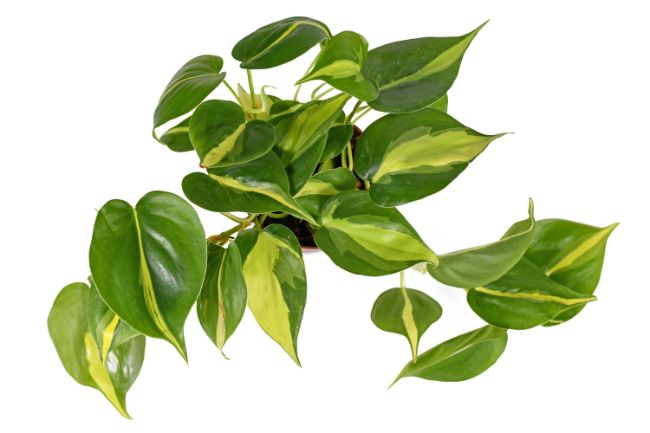
Loss Of Variegation
The Philodendron Brasil’s standout feature is its dramatic variegation, so having the plant revert to all-green foliage is a problem. Inadequate light is the most common cause, but even a healthy plant may lose color as it ages.
In a sense, variegation is a luxury that only well-lit plants can afford. Since (green) chlorophyll is where energy-producing photosynthesis happens, plants often compensate for low light by increasing the green areas of their leaves. The solution is to raise light levels.
Note: Lost variegation may not return. Keep an eye on your plant!
The cure isn’t so simple for older Philodendron Brasil plants that lose color in spite of good light, but there are steps you can take:
- If you notice an imbalance of green and variegated leaves, consider trimming to even the share. Some green leaves are necessary – a plant won’t produce adequate energy if all their leaves are variegated.
- To add variegated growth, cut the stem back to a leaf that shows variegation (don’t cut that one off!). The idea is to encourage the node to continue producing variegated foliage.
- Consider trimming highly variegated leaves. You can enjoy them for a little while, but they do pose a drain on the plant.
Toxicity
The Philodendron Brasil is toxic if ingested. It contains calcium oxalate crystals which cause mild to severe gastrointestinal upset to pets.
Though not as dangerous to humans, the crystals can cause irritation and nausea if eaten. They are the major element in kidney stones.
Varieties
The Brasil is a Philodendron hederaceum cultivar. The species is very individualistic despite sharing basic features, which has encouraged the development of varieties like the Brasil.
As exotically different as they look, the Brasil’s variegation is more like new clothes than a substantive change. It’s still a friendly, solid-green Heartleaf Philodendron underneath.
The Brasil was apparently named for having a yellow center on a green background, which (somewhat) resembles the Brazilian flag. Whether listed as a Brasil or Brazil, it’s the same plant!
Pests And Diseases
A final excellent thing about Philodendron Brasil care is its resistance to pests and disease. Besides having tough, waxy leaves that don’t easily fall to infestation, their fast growth helps them rebound from losses.
Inspect the plant at watering time, being sure to check underneath leaves where bugs like to hide. Insects huddling together are up to no good, whether they are aphids, mealybugs, thrips, spider mites, or scale. Flying pests like whitefly and gnats are other common troublemakers.
The quickest and easiest treatment is to dab the offenders with rubbing alcohol. If the situation becomes more serious, remove affected foliage and try using light horticultural oil or insecticidal soap.
These treatments are gentle to plants, but they must come into contact with pests before drying. Thoroughly cover the foliage and stems with the pesticide. Be prepared to repeat treatment every four to seven days until the infestation is gone. If you think your plant has pests or need help getting rid of them, read my guide to identifying, treating, and preventing common houseplant pests.
Prevention: The Best Disease Treatment
Philodendron Brasil’s disease issues are mainly forms of Leaf Spot. Moisture is a big contributing factor.
- Erwinia and Pseudomonas cause bacterial leaf spot.
- Dactylaria, Sclerotium (Southern Blight) and Phytophthora are fungi that damage leaves.
- Cuttings are subject to Pythium.
Preventing disease is easier than treating one – safely destroying the plant to limit the spread of infection is often the only “cure.”
Here are important prevention steps:
- Keep the plant healthy! Stress from inadequate care invites disease.
- Letting soil dry out properly is the best preventative – sometimes it even solves the problem.
- Watering philodendrons from below reduces wet foliage that can promote fungus.
- Sterile tools and potting media eliminate a major source of infection.
Isolate the plant at the first sign of disease. Maintain dry conditions with proper lighting, and provide cool temperatures of about 70ºF (21ºC).
If the infection has established itself, take cuttings of uninfected leaves and safely discard the plant.
Read more about identifying, treating, and preventing houseplant diseases in this article.

